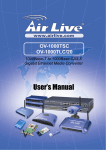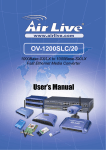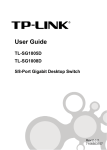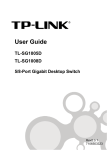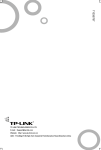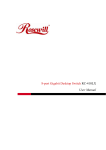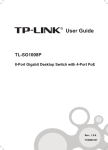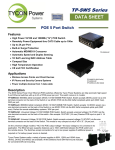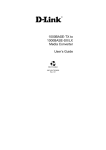Download D-Link 1000BASE-TX to 1000BASE-SX/LX Media Converter User`s guide
Transcript
1000BASE-TX to 1000BASE-SX/LX Media Converter User’s Guide Rev. 01 (JUN. 2002) Printed In Taiwan RECYCLABLE TABLE OF CONTENTS TABLE OF CONTENTS ........................ 2 INTR ODUCTION .................................. 3 ABOUT MEDIA CONVERTER ....................................... 3 PRODUCT FEATURES ......................... 3 INSTALLATION ................................... 3 SELECTING A SITE FOR THE EQUIPMENT ..................... 3 CONNECTING TO POWER ............................................. 4 INSTALLING IN A CHASSIS ........................................... 4 LED INDICATOR ......................................................... 5 LINK PASS THROUGH FUNCTION................................. 6 SWITCH ....................................................................... 6 SPECIFICATIONS ................................ 7 2 I NTRODUCTION Thank you for choosing the 1000Base Gigabit Ethernet Media Converter, The Converter introduced here provides one channel media conversion between 1000BASE-TX and 1000BASE-LX/SX. About Media Converter Media Converter is a network technology specified by IEEE 802.3ab and IEEE 802.3z 1000BASE-TX/FX standards. P RODUCT F EATURES One-channel media conversion between 1000BASE-TX and 1000BASE-SX/LX Fiber media allows: multi-mode fiber and single-mode fiber using SC connector Link Pass Through function Auto negotiation of duplex mode on TX port Auto MDI/MDI-X for TX port Full wire-speed forwarding rate Front panel status LEDs Used as a stand-alone device or with a chassis Hot-swappable when used with a chassis I NSTALLATION This chapter gives step-by-step installation instructions for the Converter. Selecting a Site for the Equipment As with any electric device, you should place the equipment where it will not be subjected to extreme temperatures, humidity, or electromagnetic interference. Specifically, the site you select should meet the following requirements: 3 1. 2. 3. 4. 5. The ambient temperature should be between 32 and 104 degrees Fahrenheit (0 to 40 degrees Celsius). The relative humidity should be less than 90 percent, non-condensing. Surrounding electrical devices should not exceed the electromagnetic field (RFC) standards for IEC 801-3, Level 2 (3V/M) field strength. Make sure that the equipment receives adequate ventilation. Do not block the ventilation holes on each side of the switch or the fan exhaust port on the side or rear of the equipment. The power outlet should be within 1.8 meters of the switch. Connecting to Power 1. 2. This Converter is a plug-and-play device. Connect the supplied AC to DC power adaptor with a power voltage of 7.5Vdc/1.5Amp to the DC-Jack on the converter, and then attach the plug into a standard AC outlet. ATTENTION! Please be sure that the other end will be connected to a switch that set to Full Duplex (forced mode) Installing in a Chassis The Converter can be fit into any of the expansion slots on a special designed chassis. 4 First, install the converter onto a carrier supplied with the chassis: Step 1- Unscrew and pull out the media converter board. Step 2- Plug in the media board to any of the vacant slot. Step 3- Fit the converter onto the carrier and use the screw to secure it. LED Indicator The LED indicators give you instant feedback on status of the converter: LEDs State Indication Power (PWR) Steady Power on Lights off Power off Lights on Linking Lights off Not Linking LINK/ACT 5 Link Pass Through Function LLCF (Link Loss Carry Forward) When a device connected to the converter and the TP line loss the link, the converter’s fiber will disconnect the link of transmit, so that the other ends will know that there is a linkage error on this end. And when the Fiber line loss the link, the converter’s TP will disconnected, and the other end will know that there is linkage problem exist. There is a default LLCF setting on this converter. LLR (Link Loss Return) When a device connected to the converter and the fiber line loss the link, the converter’s fiber will disconnect the link of transmit. There is a switch to enable or disable the function of the media converter. 12 Switch 1 : On -> Forced Mode Off -> Auto Negotiation mode Switch 2 : On -> LLR enable Off -> LLR disable 12 Switch There is a two pin DIP switch on the module which define as switch 1 and switch 2: Switch 1: Fiber mode switch When the switch was turned to “On”, it means that the 6 fiber was turned to forced mode, and “Off” for auto-negotiation mode. Note: Be sure the opposite end is using the same setting(forced or Auto-negotiation). And when using two converters at the same time, the two converters MUST set to forced mode. Switch 2: LLR When the switch was turned to “On”, it means that the LLR was enabled and “Off” for disabled. Note: When using two converters at the same time, then only one converter need to enable the LLR function. S PECIFICATIONS Standards: Data Transfer Rate: Duplex Mode: LED indicators: Media Interface: EMI Compatiblity: Temperture: Humidity: Power Consumption: IEEE802.3ab 1000BASE-TX IEEE802.3z 1000BASE-SX/LX 1488000pps for 1000Mbps Full Duplex Mode PWR, LNK/ACT RJ-45, SC FCC Class B CE Certification, Class B VCCI Class B Storage: -10°C ~ 70°C Operating: 0°C ~ 40°C 10% ~90% non-condensing 5.5 Watts (maximum) 7







